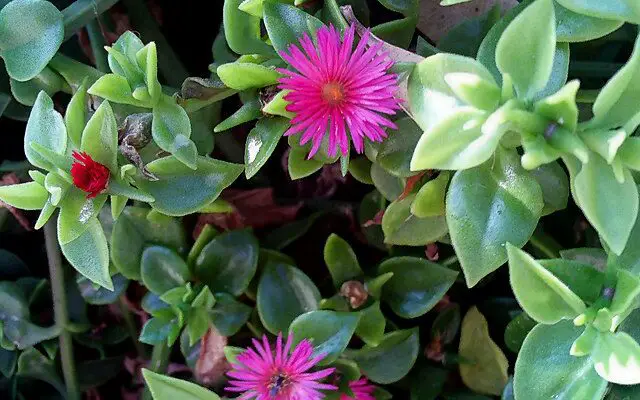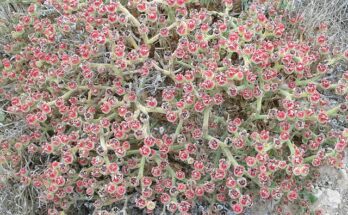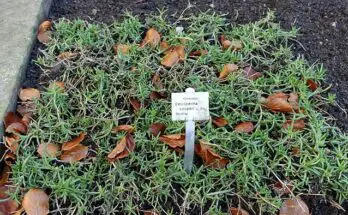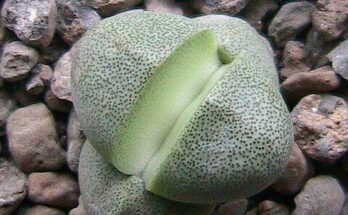Aptenia cordifolia, commonly known as Baby Sunrose, is a charming succulent that graces many gardens with its vibrant, daisy-like flowers and lush green foliage. This perennial plant, originating from South Africa, has gained popularity for its ease of care and appealing aesthetics.
Baby Sunrose Care
Caring for Baby Sunrose involves understanding its basic needs. Aptenia cordifolia thrives in environments that mimic its native habitat. It prefers a sunny location where it can receive ample light. However, it is tolerant of partial shade, which can be beneficial during the hottest parts of the day or in extremely warm climates.
Baby Sunrose Soil
Soil is a critical factor in the growth and health of Baby Sunrose. The right soil mix ensures proper drainage and aeration, which are essential for the roots. This section explores the importance of soil composition and how it affects the plant’s overall well-being.
Creating the Ideal Soil Mix Discover how to create the perfect soil environment for Baby Sunrose. Whether you choose a commercial cacti and succulent mix or decide to make your own, this part details the necessary components and proportions for a well-draining and nutritious soil blend.
Preventing Soil Compaction Learn about the impact of soil compaction on water drainage and root health. This subsection provides tips on how to maintain loose and breathable soil, ensuring the longevity and vigor of your Baby Sunrose.
Baby Sunrose Watering Techniques
Balancing Water Needs Understanding the watering needs of Baby Sunrose is vital for its survival. This section delves into how to strike the right balance between providing enough moisture for growth and avoiding the pitfalls of overwatering.
Seasonal Watering Adjustments The watering requirements for Baby Sunrose change with the seasons. In this part, get insights into how to modify your watering routine in response to the plant’s dormancy period and active growth phases.
Detecting Water-Related Issues Recognizing the signs of overwatering and underwatering can save your plant from potential damage. This subsection guides you through the symptoms to watch out for and how to adjust your watering practices accordingly.
The Importance of Water Quality Explore the often-overlooked aspect of water quality and its impact on Baby Sunrose. Learn why certain types of water are better for your plant and how to ensure you’re providing the best for its growth.
By comprehensively understanding the soil and watering needs, you can create a thriving environment for your Baby Sunrose. This guide equips you with the knowledge to expertly navigate these crucial aspects of plant care.
Propagation Techniques
Propagating Baby Sunrose is straightforward. Cuttings can be taken from healthy plants, ideally during the spring or early summer. Let the cutting dry for a day or two to form a callous, then plant it in well-draining soil. With proper care, roots will develop, and a new plant will emerge.
Step-by-Step Guide to Propagating Baby Sunrose from Cuttings:
- Timing and Selection: The best time for propagation is during the spring or early summer when the plant is in its active growth phase. This ensures a higher success rate as the plant is more resilient and ready to grow. Begin by selecting a healthy stem from your Baby Sunrose. Look for stems that are robust, free from pests, and have a good amount of foliage.
- Preparing the Cutting: Using a clean, sharp knife or scissors, cut a 4-6 inch length of stem. It’s important to make a clean cut to prevent damage to the parent plant and to enhance the cutting’s chances of rooting. Remove the lower leaves to expose a bare stem, which will be inserted into the soil.
- Callousing the Cutting: After cutting, lay the stem on a dry, clean surface in a shaded area to allow the cut end to callous over. This process usually takes 1-2 days. Callousing is crucial as it helps to prevent rot when the cutting is planted.
- Planting the Cutting: Once the cut end is calloused, plant the cutting in a pot filled with well-draining soil. A mix specifically designed for cacti and succulents is ideal. Insert the bare stem into the soil, ensuring it stands upright. Firm the soil around the base for stability.
- Initial Watering: After planting, lightly water the soil to moisten it. However, avoid overwatering as this can lead to rot. The soil should be barely moist, not wet.
- Root Development: Place the pot in a warm, bright location but out of direct sunlight. The cutting doesn’t need strong light until roots have formed. Water sparingly, only when the soil feels dry to the touch. In a few weeks, gently tug on the cutting to check for resistance, indicating root development.
- Aftercare: Once the cutting has established roots, you can gradually introduce it to more sunlight. Continue to water when the soil is dry, and begin a regular feeding program with a diluted succulent fertilizer during the growing season.
- Observing Growth: Over time, the new Baby Sunrose plant will begin to show new growth. This is a sign that it has adapted well and is thriving. Regular pruning and pinching back can encourage bushier growth.
- Troubleshooting: If a cutting fails to root or shows signs of rot, it’s important to assess the conditions. Overwatering, too much direct sunlight, or excessively humid conditions can hinder rooting. Adjust the environment accordingly and try with a new cutting if necessary.
By following these detailed steps, gardeners can successfully propagate Baby Sunrose plants, enjoying the process of nurturing new growth from cuttings. This method not only adds to your garden but also allows you to share this delightful succulent with friends and fellow plant enthusiasts.
Blooming Time and Flowering
One of the delights of Baby Sunrose is its blooming season. Typically, it flowers in spring and summer, offering a splash of color with its pink or red blooms. If your Baby Sunrose is not flowering, it may be due to insufficient light or nutrient deficiencies. Ensuring adequate sunlight and occasional fertilization during the growing season can encourage blooming.
Cold Tolerance and Winter Care
While Baby Sunrose is a hardy plant, it has limited cold tolerance. In regions with cold winters, it’s best to bring it indoors or provide protection from frost. Indoor care involves placing it in a bright spot and reducing watering, as the plant enters a dormant phase in cooler temperatures.
Optimal Growing Conditions for Health and Vigor
For robust growth, Baby Sunrose requires a balance of full sun, moderate watering, and well-draining soil. It can tolerate some neglect, making it a suitable choice for both beginner and experienced gardeners. Regular pruning can help maintain its shape and encourage fuller growth.
Indoor Cultivation
Growing Baby Sunrose indoors can be successful with the right conditions. Place the plant near a sunny window where it can receive plenty of light. Be mindful of watering, as indoor plants may require less frequent watering compared to those outdoors.
Baby Sunrose, with its vibrant blooms and resilient nature, is a delightful addition to any succulent collection. By understanding its care requirements and propagation methods, you can enjoy the beauty and satisfaction this plant brings to your home or garden. Whether you’re a seasoned gardener or a novice, Baby Sunrose offers a rewarding and enriching gardening experience.





